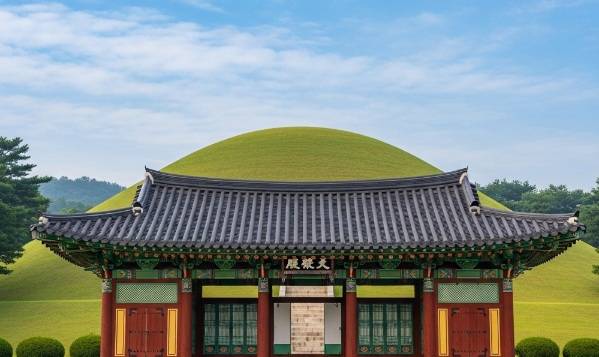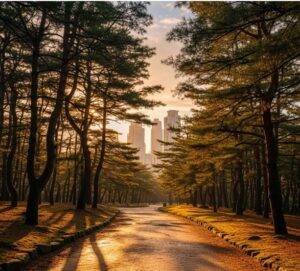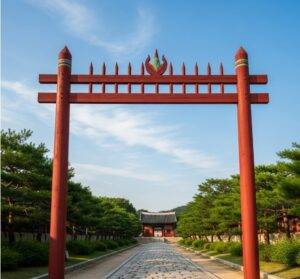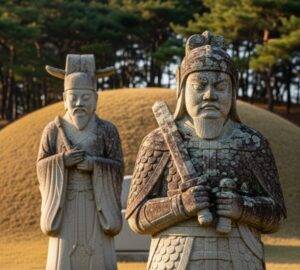In the glittering, high-rise district of Gangnam, where the pulse of modern Seoul beats fastest, lies an anchor to a quieter, more profound past. Seonjeongneung is more than just a green space; it’s a sacred burial ground for Joseon kings and queens, a place of deep historical resonance. This comprehensive Seonjeongneung Tombs walking guide is designed to be your personal companion as you explore this remarkable site, transforming a simple walk into a journey through time. If you’re visiting on a late Saturday afternoon like today, the low September sun casts long, dramatic shadows from the ancient pine trees, making it one of the truly special quiet places in Seoul just as the rest of the city gears up for the evening. Let’s step away from the noise and into the story.
Seoul’s Royal Oasis: Why Seonjeongneung is a UNESCO World Heritage Site
Before we begin our walk, it’s important to understand why this place is so special. Seonjeongneung is part of the Royal Tombs of the Joseon Dynasty, a collection of 40 tombs spread across 18 locations that were collectively designated a UNESCO World Heritage Site in 2009.
These aren’t just graves; they are masterpieces of landscape architecture and Confucian tradition. The sites for the Joseon Dynasty Royal Tombs were carefully chosen based on pungsu (Korean feng shui), considering the harmony of mountains, water, and orientation. The layout, stone objects, and surrounding nature all work together to create a sacred space that honors the dead and connects the worlds of the living and the divine. Seonjeongneung is one of the most accessible of these sites, a perfectly preserved historical sanctuary and one of the most unique parks in Gangnam.
Meet the Royals: Seolleung and Jeongneung Tombs Explained
The name “Seonjeongneung” (선정릉) is a portmanteau of the two main tomb areas within the park: Seolleung (선릉) and Jeongneung (정릉). Here’s who you will be “meeting” on your walk:
-
Seolleung (선릉): This area contains two royal tombs.
- King Seongjong (1457-1494): The 9th king of the Joseon Dynasty. He was a great patron of the arts and sciences, and his reign is considered a golden age of cultural prosperity. He commissioned the Gyeongguk daejeon, the first complete code of law for the dynasty.
- Queen Jeonghyeon (1462-1530): King Seongjong’s third wife and the mother of King Jungjong. Her tomb was originally located elsewhere but was moved here to be beside her husband.
-
Jeongneung (정릉): This is a single tomb.
- King Jungjong (1488-1544): The 11th king of the Joseon Dynasty and the son of King Seongjong. His reign was marked by political turmoil and attempts at reform. His is the only one of the three tombs here that stands alone.
Your Recommended Walking Path: A Seonjeongneung Tombs walking guide
This path is designed to be logical and to build the experience layer by layer. Follow these steps from the main entrance.
Step 1: The Red-Spiked Gate and the Royal Pathway
After purchasing your ticket, you’ll immediately face the Hongsalmun (홍살문), a distinctive gate with red-spiked arrows on top. This gate marks the entrance to a sacred realm. Pass through it and you’ll see a stone path with two levels. The slightly elevated path, the Sindo (신도), was for the spirit of the king. The lower path, the Eodo (어도), was for the living king during memorial rites. As visitors, we walk alongside this ceremonial walkway.
Step 2: Paying Respects at Jeongneung Tomb (King Jungjong)
Follow the main path to the right. The first major structure you will encounter is the T-shaped wooden shrine called the Jeongjagak (정자각). This is where memorial rites were performed. Behind it, up on the hill, you can see the burial mound, or Bongbun (봉분), of King Jungjong. The tomb area itself is off-limits to visitors to preserve it, but from the shrine, you get a clear and respectful view of the entire complex, including the stone guardians standing watch.
Step 3: The Forest Trail to Seolleung Tombs
From Jeongneung, instead of backtracking, take the beautiful forest path that winds its way uphill. This is where you truly feel the site’s power as one of the most peaceful parks in Gangnam. The sounds of the city fade, replaced by birdsong and the rustling of leaves. The path is well-maintained and offers several benches if you wish to simply sit and absorb the serene atmosphere.
Step 4: Visiting Seolleung (King Seongjong & Queen Jeonghyeon)
The forest path will lead you to the Seolleung area. Here you’ll find a similar layout to Jeongneung, but with two tomb mounds visible up on the hill. The Jeongjagak shrine here served both King Seongjong and Queen Jeonghyeon. Take a moment to appreciate the scale and symmetry of the layout. The left mound is for King Seongjong, and the right is for his queen. This is the heart of the site and a perfect place for quiet contemplation.
Decoding the Symbolism: The Meaning of the Stone Statues
Surrounding the burial mounds are a host of stone figures, each with a specific purpose. They are silent guardians who have watched over the royals for centuries.
- Civil Officials (Muninseok, 문인석): Standing closer to the tomb, these statues represent scholars and government officials. They hold a scepter and are depicted in a posture of quiet service, advising the king in the afterlife.
- Military Officials (Muinseok, 무인석): Positioned further out, these are warrior statues. They are larger, carry swords, and have a sterner expression, ready to protect the king from evil spirits.
- Stone Animals: You will also see stone horses (Seokma, 석마), which provide transport for the spirits, and stone sheep (Seogyang, 석양) and tigers (Seokho, 석호), which guard the mound itself and ward off evil.
Conclusion: A Timeless Experience
Walking through Seonjeongneung is to walk through layers of history, nature, and philosophy. It’s a powerful reminder that even in one of the world’s most dynamic cities, there are places of profound stillness and memory. You came looking for a historical site, but you leave with a sense of peace and a deeper connection to Seoul’s long and fascinating story.
Further Reading Suggestion: For those interested in a deeper dive into the fascinating era these tombs represent, “The Annals of the Joseon Dynasty” provides an unparalleled, detailed account of the period.
Frequently Asked Questions (FAQ)
What are the opening hours and entrance fee?
Opening hours vary by month but are generally from 6:00/6:30 AM to 9:00 PM (last admission at 8:00 PM). The tombs are closed on Mondays. The entrance fee is very affordable, typically 1,000 KRW for adults.
How do I get to Seonjeongneung Tombs by subway?
It’s very easy. Take Seoul Subway Line 9 or the Suin-Bundang Line to Seonjeongneung Station (선정릉역). Exit 3 will place you directly in front of the main entrance.
How much time should I plan for the full walking route?
To comfortably walk the entire recommended path, read the informational signs, and spend some time in quiet reflection, you should plan for about 60 to 90 minutes.
Are there restrooms and other facilities available on site?
Yes, there are clean public restrooms located near the main entrance. You’ll also find a small history and culture center providing more information about the Joseon Royal Tombs.
Hi, I’m [jeybee]. As a long-time resident of Seoul, I’m passionate about uncovering the authentic, everyday magic of Korea. This blog is my way of sharing my favorite spots, tips, and cultural insights with you, beyond the usual tourist traps.




